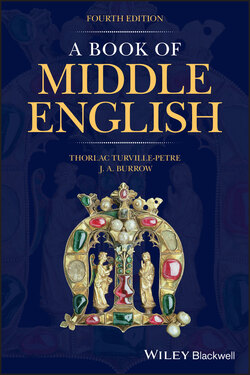Читать книгу A Book of Middle English - J. A. Burrow - Страница 35
4.3.2 First and Second Person Pronouns
ОглавлениеForms of the first and second person pronouns survived throughout the Middle English period with little change. From an early date ich is often reduced to I, as in I ne can ne I ne mai, 1/33, and in some dialects ich is attached to a verb beginning with a vowel or h or w, as in ichil, ‘I will’, 5/132, ichot (ich + wot), ‘I know’, 14g/10. Similarly þou is sometimes attached to the verb it follows, in which case its consonant is assimilated into the preceding /t/ of the verb‐ending: artow (for art þow), 5/421; neltu, ‘will you not’ (ne + wult + þu), 2/150. Min and þin are often reduced to mi and þi, but the full forms are retained before vowels and h: þi reson … þin affeccion, 6/24–5. The second person plural forms show only few variations in spelling in our texts (e.g. ʒe and ye, ow and ʒou, ower and ʒour). The general use of you as a nominative form is a development of Early Modern English, and in Middle English the distinction between the nominative ʒe and the accusative/dative ow or ʒou is generally well preserved. (On the usage of þou and ʒe see 5.4.1.)
The Old English ‘dual’ pronouns (meaning ‘we two’ and ‘you two’) survived for a short while; e.g. nominative wit, ‘we two’, 3/151, genitive unker, ‘of us two’, 2/151.
